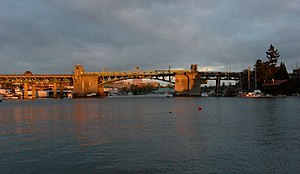Portage Bay
| Portage Bay | ||
|---|---|---|
|
Looking east across Portage Bay to University Bridge and beyond; the University of Washington's south campus can be seen from under the bridge. |
||
| Waters | Lake Washington Ship Canal | |
| Land mass | North America | |
| Geographical location | 47 ° 38 '48 " N , 122 ° 18' 46" W | |
|
|
||
| width | approx. 500 m | |
| depth | approx. 1.5 km | |
|
Portage Bay (July 1931) |
||
The Portage Bay is a body of water that often for the eastern arm of Lake Union is held. It forms part of the Lake Washington Ship Canal in Seattle , Washington State .
To the east, Portage Bay is connected to Union Bay - part of Lake Washington - by the Montlake Cut , over which the Montlake Bridge leads to Washington State Route 513 . To the north is the University of Washington campus . To the west, Portage Bay is crossed by the University Bridge, which carries Eastlake Avenue between the Eastlake district and the University District. The Ship Canal Bridge, which spans Interstate 5 across the water, can be seen as its westernmost limit ; beyond this bridge, the body of water is considered part of Lake Union. In the south, Portage Bay is spanned by the Portage Bay Viaduct, which carries Washington State Route 520 between the Eastlake / Capitol Hill and Montlake neighborhoods.
Portage Bay was so named in 1913 because the transports (English "portage") of felled timber over the Montlake Isthmus used the water between Union Bay and Lake Union before the construction of the Lake Washington Ship Canal. Portage Bay is home to two yacht clubs, the Seattle Yacht Club and the Queen City Yacht Club , and many houseboats , as well as the Northwest Fisheries Science Center of the National Marine Fisheries Service and the College of Ocean and Fishery Science of the University of Washington.
history
Landowner Harvey Pike attempted to dig a first trench connecting Union Bay on Lake Washington and Portage Bay on Lake Union in 1860, but gave up and transferred the land to the Lake Washington Ship Canal Company , which operated a freight tram for transport between the lakes built. This railway line was in use until 1878. David Denny and Thomas Burke built a canal for rafting felled wood in 1883.
Cheshiahud lived on the shores of Portage Bay for many years from 1885, pushing canoes over land. The Pay Streak , a variety and accompaniment company of the World's Fair of 1909 ("Alaska-Yukon-Pacific Exposition"), ended with a gondola ride and boardwalk on the north shore of Portage Bay.
In the 14 years following World War II, the Fantome was in Portage Bay because of unpaid taxes.
District
The small district of Portage Bay is located on the southwestern shore of the bay. It is bounded on the south by Washington State Route 520 and on the west by Interstate 5 . This is one of the larger remaining houseboat developments in Seattle.
Individual evidence
- ↑ Harry M. Majors: Exploring Washington . Van Winkle Publishing Co, 1975, ISBN 978-0-918664-00-6 , p. 78.
- ^ Priscilla Long: Montlake log canal first connects Seattle's Union and Portage bays in 1861 . In: HistoryLink.org essay 3404 . Retrieved April 29, 2011.
- ^ Priscilla Long: 9 Chinese laborers dig second Montlake Cut between Union Bay and Portage Bay in 1883 . In: HistoryLink.org essay 3349 . HistoryLink.org. May 4, 2012. Retrieved April 29, 2011.
- ^ Alaska-Yukon-Pacific Exposition, 1909 - A Slideshow of Seattle's First World's Fair . In: HistoryLink.org Essay 7082 . HistoryLink.org. Retrieved April 29, 2011.



